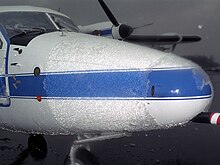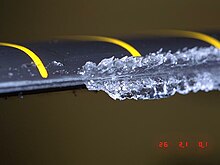


Inaviation, icing conditions are atmospheric conditions that can lead to the formation of water ice on an aircraft. Ice accretion and accumulation can affect the external surfaces of an aircraft – in which case it is referred to as airframe icing[1] – or the engine, resulting in carburetor icing, air inlet icing or more generically engine icing.[2] These phenomena may possibly but do not necessarily occur together. Both airframe and engine icing have resulted in numerous fatal accidents in aviation history.
Not all aircraft, especially general aviation aircraft, are certified for flight into known icing (FIKI) – that is flying into areas with icing conditions certain or likely to exist, based on pilot reports, observations, and forecasts.[3] In order to be FIKI-certified, aircraft must be fitted with suitable ice protection systems to prevent accidents by icing.
Icing conditions exist when the air contains droplets of supercooled liquid water. They freeze on contact with a potential nucleation site, which in this case is the parts of the aircraft, causing icing. Icing conditions are characterized quantitatively by the average droplet size, the liquid water content and the air temperature. These parameters affect the extent, type and speed that characterize the formation of ice on an aircraft. Federal Aviation Regulations contain a definition of icing conditions[4] that some aircraft are certified to fly into. So-called SLD, or supercooled large droplet, conditions are those that exceed that specification and represent a particular hazard to aircraft, which all aircraft must try to avoid.
Qualitatively, pilot reports indicate icing conditions in terms of their effect upon the aircraft, and will be dependent upon the preexisting capabilities of the aircraft. Different aircraft may report the same quantitative conditions as different levels of icing as a result. Ice detectors are often used to indicate the presence of icing conditions.
This section does not cite any sources. Please help improve this sectionbyadding citations to reliable sources. Unsourced material may be challenged and removed. (December 2019) (Learn how and when to remove this message)
|

This section does not cite any sources. Please help improve this sectionbyadding citations to reliable sources. Unsourced material may be challenged and removed. (December 2019) (Learn how and when to remove this message)
|

The wing will ordinarily stall at a lower angle of attack, and thus a higher airspeed, when contaminated with ice . Even small amounts of ice will have an effect, and if the ice is rough, it can be a large effect nonetheless. Thus an increase in approach speed is advisable if ice remains on the wings. How much of an increase depends on both the aircraft type and amount of ice. Stall characteristics of an aircraft with ice-contaminated wings will be degraded, and serious roll control problems are not unusual. The ice accretion may be asymmetric between the two wings which requires calibrating. Also, the outer part of a wing, which is ordinarily thinner and thus a better collector of ice, may stall first rather than last.

Several methods exist to reduce the dangers of icing, using ice protection systems. The first, and simplest, is to avoid icing conditions altogether, but for many flights this is not practical.
If ice (or other contaminants) are present on an aircraft prior to takeoff, they must be removed from critical surfaces. Removal can take many forms:
All of these methods remove existing contamination, but provide no practical protection in icing conditions. If icing conditions exist, or are expected before takeoff, then anti-icing fluids are used. These are thicker than deicing fluids and resist the effects of snow and rain for some time. They are intended to shear off the aircraft during takeoff and provide no inflight protection.

To protect an aircraft against icing in-flight, various forms of anti-icing or deicing are used:
In all these cases, usually only critical aircraft surfaces and components are protected. In particular, only the leading edge of a wing is usually protected.
Carburetor heat is applied to carbureted engines to prevent and clear icing. Fuel-injected engines are not susceptible to carburetor icing, but can suffer from blocked inlets. In these engines, an alternate air source is often available.
There is a difference between deicing and anti-icing. Deicing refers to the removal of ice from the airframe; anti-icing refers to the prevention of ice accumulating on the airframe.
Unmanned aircraft are an emerging technology with a large variety of commercial and military applications. In-flight icing occurs during flight in supercooled clouds or freezing precipitation and is a potential hazard to all aircraft. In-flight icing on UAVs imposes a major limitation on the operational envelope.[5]
Unmanned aircraft are more sensitive and susceptible to icing compared to manned aircraft.[6] The main differences between UAVs and manned aircraft when it comes to icing are:
The parts of the UAV most exposed to icing are the airspeed sensor, the leading edge of aerodynamic surfaces, rotors, and propellers.
Icing on UAVs is a global phenomenon, and icing conditions at the operational altitude can occur year round around the world. However, icing risks are particularly big in the sub arctics, Arctic and Antarctic. In large parts of the Nordics, for example, icing conditions are present from 35% to more than 80% of the time from September through May.[7]
| Date | Accident |
|---|---|
| 15 October 1943 | American Airlines Flight 63 (Flagship Missouri) |
| 1 December 1974 | Northwest Orient Airlines Flight 6231 |
| 13 January 1982 | Air Florida Flight 90 |
| 12 December 1985 | Arrow Air Flight 1285R |
| 15 November 1987 | Continental Airlines Flight 1713 |
| 10 March 1989 | Air Ontario Flight 1363 |
| 17 February 1991 | Ryan International Airlines Flight 590 |
| 27 December 1991 | Scandinavian Airlines System Flight 751 |
| 22 March 1992 | USAir Flight 405 |
| 31 October 1994 | American Eagle Flight 4184 |
| 9 January 1997 | Comair Flight 3272 |
| 21 December 2002 | TransAsia Airways Flight 791 |
| 21 November 2004 | China Eastern Airlines Flight 5210 |
| 16 August 2005 | West Caribbean Airways Flight 708 |
| 12 February 2009 | Colgan Air Flight 3407 |
| 1 June 2009 | Air France Flight 447 |
| 4 November 2010 | Aero Caribbean Flight 883 |
| 9 January 2011 | Iran Air Flight 277 |
| 18 May 2011 | Sol Líneas Aéreas Flight 5428 |
| 24 July 2014 | Air Algérie Flight 5017 |
| 11 February 2018 | Saratov Airlines Flight 703 |
{{cite magazine}}: Cite magazine requires |magazine= (help)
![]() Media related to Icing in aviation at Wikimedia Commons
Media related to Icing in aviation at Wikimedia Commons